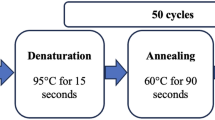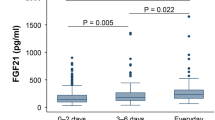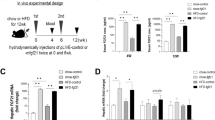Abstract
Fibroblast growth factor 21 (FGF21) is a novel master regulator of metabolic profile. The biological actions of FGF21 are elicited upon its klotho beta (KLB)-facilitated binding to FGF receptor 1 (FGFR1), FGFR2 and FGFR3. We hypothesised that common polymorphisms in the FGF21 signalling pathway may be associated with metabolic risk. At the screening stage, we examined associations between 63 common single-nucleotide polymorphisms (SNPs) in five genes of this pathway (FGF21, KLB, FGFR1, FGFR2, FGFR3) and four metabolic phenotypes (LDL cholesterol – LDL-C, HDL-cholesterol – HDL-C, triglycerides and body mass index) in 629 individuals from Silesian Hypertension Study (SHS). Replication analyses were performed in 5478 unrelated individuals of the Swiss CoLaus cohort (imputed genotypes) and in 3030 directly genotyped individuals of the German Myocardial Infarction Family Study (GerMIFS). Of 54 SNPs that met quality control criteria after genotyping in SHS, 4 (rs4733946 and rs7012413 in FGFR1; rs2071616 in FGFR2 and rs7670903 in KLB) showed suggestive association with LDL-C (P=0.0006, P=0.0013, P=0.0055, P=0.011, respectively) and 1 (rs2608819 in KLB) was associated with body mass index (P=0.011); all with false discovery rate q<0.5. Of these, only one FGFR2 polymorphism (rs2071616) showed replicated association with LDL-C in both CoLaus (P=0.009) and men from GerMIFS (P=0.017). The direction of allelic effect of rs2071616 upon LDL-C was consistent in all examined populations. These data show that common genetic variations in FGFR2 may be associated with LDL-C in subjects of white European ancestry.
Similar content being viewed by others
Log in or create a free account to read this content
Gain free access to this article, as well as selected content from this journal and more on nature.com
or
References
Moore DD : Physiology. Sister act. Science 2007; 316: 1436–1438.
Kharitonenkov A, Shiyanova TL, Koester A et al: FGF-21 as a novel metabolic regulator. J Clin Invest 2005; 115: 1627–1635.
Inagaki T, Dutchak P, Zhao G et al: Endocrine regulation of the fasting response by PPARalpha-mediated induction of fibroblast growth factor 21. Cell Metab 2007; 5: 415–425.
Kurosu H, Choi M, Ogawa Y et al: Tissue-specific expression of betaKlotho and fibroblast growth factor (FGF) receptor isoforms determines metabolic activity of FGF19 and FGF21. J Biol Chem 2007; 282: 26687–26695.
Ogawa Y, Kurosu H, Yamamoto M et al: BetaKlotho is required for metabolic activity of fibroblast growth factor 21. Proc Natl Acad Sci USA 2007; 104: 7432–7437.
Suzuki M, Uehara Y, Motomura-Matsuzaka K et al: bet}Klotho is required for fibroblast growth factor (FGF) 21 signaling through FGF receptor (FGFR) 1c and FGFR3c. Mol Endocrinol 2008; 22: 1006–1014.
Kharitonenkov A, Dunbar JD, Bina HA et al: FGF-21/FGF-21 receptor interaction and activation is determined by betaKlotho. J Cell Physiol 2008; 215: 1–7.
Tomaszewski M, Charchar FJ, Lynch MD et al: Fibroblast growth factor 1 gene and hypertension: from the quantitative trait locus to positional analysis. Circulation 2007; 116: 1915–1924.
Firmann M, Mayor V, Vidal PM et al: The CoLaus study: a population-based study to investigate the epidemiology and genetic determinants of cardiovascular risk factors and metabolic syndrome. BMC Cardiovasc Disord 2008; 8: 6.
Tobin MD, Sheehan NA, Scurrah KJ, Burton PR : Adjusting for treatment effects in studies of quantitative traits: antihypertensive therapy and systolic blood pressure. Stat Med 2005; 24: 2911–2935.
Broeckel U, Hengstenberg C, Mayer B et al: A comprehensive linkage analysis for myocardial infarction and its related risk factors. Nat Genet 2002; 30: 210–214.
Tomaszewski M, Charchar FJ, Samani NJ : Association studies in current cardiovascular genetics - functional variants, tags or both? J Hum Hypertens 2007; 21: 425–426.
Horvath S, Xu X, Laird NM : The family based association test method: strategies for studying general genotype--phenotype associations. Eur J Hum Genet 2001; 9: 301–306.
Yan J : Yet another package for Generalized Estimating Equations. R-News 2002; 2/3: 12–14.
Cupples LA, Arruda HT, Benjamin EJ et al: The Framingham Heart Study 100K SNP genome-wide association study resource: overview of 17 phenotype working group reports. BMC Med Genet 2007; 8 (Suppl 1): S1.
Samani NJ, Erdmann J, Hall AS et al: Genomewide association analysis of coronary artery disease. N Engl J Med 2007; 357: 443–453.
Erdmann J, Grosshennig A, Braund PS et al: New susceptibility locus for coronary artery disease on chromosome 3q22.3. Nat Genet 2009; 41: 280–282.
Storey JD, Tibshirani R : Statistical significance for genomewide studies. Proc Natl Acad Sci USA 2003; 100: 9440–9445.
Barrett JC, Fry B, Maller J, Daly MJ : Haploview: analysis and visualization of LD and haplotype maps. Bioinformatics 2005; 21: 263–265.
Tomaszewski M, Brain NJ, Charchar FJ et al: Essential hypertension and beta2-adrenergic receptor gene: linkage and association analysis. Hypertension 2002; 40: 286–291.
Kharitonenkov A, Wroblewski VJ, Koester A et al: The metabolic state of diabetic monkeys is regulated by fibroblast growth factor-21. Endocrinology 2007; 148: 774–781.
Badman MK, Pissios P, Kennedy AR, Koukos G, Flier JS, Maratos-Flier E : Hepatic fibroblast growth factor 21 is regulated by PPARalpha and is a key mediator of hepatic lipid metabolism in ketotic states. Cell Metab 2007; 5: 426–437.
Potthoff MJ, Inagaki T, Satapati S et al: FGF21 induces PGC-1alpha and regulates carbohydrate and fatty acid metabolism during the adaptive starvation response. Proc Natl Acad Sci USA 2009; 106: 10853–10858.
Christodoulides C, Dyson P, Sprecher D, Tsintzas K, Karpe F : Circulating fibroblast growth factor 21 is induced by peroxisome proliferator-activated receptor agonists but not ketosis in man. J Clin Endocrinol Metab 2009; 94: 3594–3601.
Moyers JS, Shiyanova TL, Mehrbod F et al: Molecular determinants of FGF-21 activity-synergy and cross-talk with PPARgamma signaling. J Cell Physiol 2007; 210: 1–6.
Hughes SE : Differential expression of the fibroblast growth factor receptor (FGFR) multigene family in normal human adult tissues. J Histochem Cytochem 1997; 45: 1005–1019.
Yie J, Hecht R, Patel J et al: FGF21 N- and C-termini play different roles in receptor interaction and activation. FEBS Lett 2009; 583: 19–24.
Katoh M : Cancer genomics and genetics of FGFR2 (Review). Int J Oncol 2008; 33: 233–237.
de Bakker PI, Ferreira MA, Jia X, Neale BM, Raychaudhuri S, Voight BF : Practical aspects of imputation-driven meta-analysis of genome-wide association studies. Hum Mol Genet 2008; 17 (R2): R122–R128.
Acknowledgements
This project was supported by NIH Fogarty International Research Collaboration Award (R03 TW007165; to MT). BMK's fellowship in Leicester was supported by the EU project Cardiogenics (LSHM-CT-2006-037593). TAB was supported by a British Heart Foundation project Grant (PG/06/097; to MT). NJS holds a British Heart Foundation Chair of Cardiology. This study is a part of the research portfolio supported by the Leicester NIHR Biomedical Research Unit in Cardiovascular Disease. The CoLaus study was supported by research Grants from GlaxoSmithKline and from the Faculty of Biology and Medicine of Lausanne, Switzerland, and is currently supported by the Swiss National Science Foundation (Grant no: 33CSCO-122661). We are grateful to Dr Allan Beveridge for support in bioinformatic analysis.
Author information
Authors and Affiliations
Corresponding author
Ethics declarations
Competing interests
The authors declare no conflict of interest.
Additional information
Supplementary Information accompanies the paper on European Journal of Human Genetics website
Supplementary information
Rights and permissions
About this article
Cite this article
Kaess, B., Barnes, T., Stark, K. et al. FGF21 signalling pathway and metabolic traits – genetic association analysis. Eur J Hum Genet 18, 1344–1348 (2010). https://doi.org/10.1038/ejhg.2010.130
Received:
Revised:
Accepted:
Published:
Issue date:
DOI: https://doi.org/10.1038/ejhg.2010.130
Keywords
This article is cited by
-
Genome wide association study identifies KCNMA1contributing to human obesity
BMC Medical Genomics (2011)



